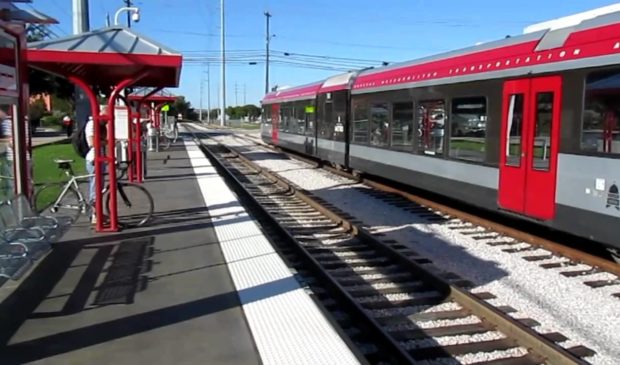Capital Metro’s newest board member Travillion talks transit
Thursday, October 12, 2017 by
Caleb Pritchard The newest member of the Capital Metropolitan Transportation Authority Board of Directors on Tuesday expressed his concern for transit-dependent residents who have been pushed out of Central Austin, a sentiment that could spell trouble ahead for the transit agency’s planned realignment of its fixed route network.
In a one-on-one chat, Travis County Commissioner Jeff Travillion told the Austin Monitor that even before taking the board post he had publicly expressed his concerns about the Connections 2025 transit plan that will relocate or eliminate many of Capital Metro’s existing routes.
“It is going to be very important for me to understand that, where there is change, we are going to directly address the needs of the people that are being impacted by it,” he said.
The Commissioners Court had just hours before voted unanimously to appoint Travillion to serve the remainder of former Capital Metro Vice Chair Beverly Silas’ term, which expires on June 1. Silas stepped down after the Monitor reported on comments she made at an August board work session in which she said she felt an African-American man should not replace outgoing agency President and CEO Linda Watson.
Travillion is joining the board just as the agency is on the cusp of several significant changes and initiatives. For one, the board is set to select Watson’s replacement in January. His colleagues have already had several months to learn about and weigh in on the hiring process.
More immediately, though, the board is scheduled to vote on the proposed June service changes on Nov. 15, and there is only a single board meeting between now and then.
The proposal stems from the Connections 2025 plan that the board adopted last year and represents a wholesale shift in the agency’s bus network. It features an emphasis on frequency and transfers rather than coverage and direct connections. Areas on the edge of Austin, including in the northeastern reaches that are part of Travillion’s Precinct 1, will see some of the most dramatic changes.
“If you’ve got significant ridership and it is consistent, and you’re moving to another place, even if there’s more frequency, I’m concerned about people who have disabilities and the elderly population that is transit dependent,” Travillion explained. “I’m very concerned about the youth that have to travel great distances to get to a place where the route might be operating more frequently. And I’m concerned about the conditions and circumstances that it’s going to take to get people from that original route to the next route. I’m not clear on that yet.”
Even though Travillion lives in Pflugerville, a city that is not part of Capital Metro’s service area, he said he will ride various buses around Austin to keep in touch with the agency’s customers. Conveniently, the No. 17 bus – one of the two routes that swings by Capital Metro headquarters – stops just outside of the Commissioners Court at 700 Lavaca St.
As Austin’s surrounding suburbs have grown in recent years, Capital Metro has invested in more commuter service to bring riders into the core. Travillion told the Monitor that that focus is incomplete.
“When we look at the system, my question is going to be whether we think about those most significant things that impact people’s lives, and that is: How they get to work, how they get to the doctor and how they get to the grocery store,” he said. “Sometimes we do a good job in the system of going long distances but not rotating and circulating in the areas that are close to folks’ homes and giving them the opportunity to do the things they need to do.”
As for MetroRail, the 32-mile Red Line from Leander to downtown Austin, Travillion suggested, “We are going to have to challenge all of our thinking.”
In recent years, the agency has showered MetroRail with tens of millions of dollars in investments, some from its general fund, and some from state and federal grants. In August, the board approved $65.7 million on upgrades mandated by the Federal Transit Administration.
Despite those investments, ridership on the Red Line ranks it as only the 10th-highest among the entire system. According to the most recent budget, the per-rider subsidy is $25, versus $6 spent on every bus rider. A Capital Metro survey in 2015 revealed that 70 percent of the train’s passengers are white, whereas whites make up only 36 percent of bus riders. Travillion acknowledged that disparity.
“I think when you address that issue, once again that is a core question issue, which is, what problem are you solving with this investment. I think that we have to better analyze the needs of our transit-dependent community,” he said.
As for Project Connect, Travillion insisted on the importance of a data-driven process. He also suggested that the initiative’s success hinges on better public engagement.
“I want to be sure that we are talking to the right people in the right places. I want to make sure that we aren’t creating new meetings and asking people to come where we are, but that we are understanding where the community meets and going there,” he said.
Photo courtesy of YouTube.
The Austin Monitor’s work is made possible by donations from the community. Though our reporting covers donors from time to time, we are careful to keep business and editorial efforts separate while maintaining transparency. A complete list of donors is available here, and our code of ethics is explained here.
You're a community leader
And we’re honored you look to us for serious, in-depth news. You know a strong community needs local and dedicated watchdog reporting. We’re here for you and that won’t change. Now will you take the powerful next step and support our nonprofit news organization?








